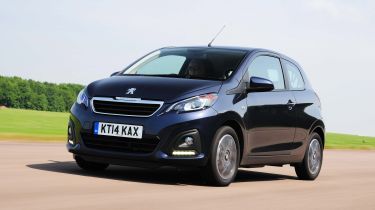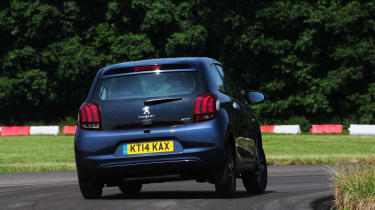Peugeot 108 (2014-2022) review - Engines, performance and drive
A power hike is designed to make the 1.0 more appealing, but it's still at its best in town

The Peugeot 108's predecessor, the 107, was an easy-to-drive city car, but it didn’t score highly in terms of refinement or fun. Since the 108 shares the same basic chassis, you could be forgiven for thinking it’s just got a pretty new body.
However, refinement at speed has been improved, with road and wind noise better isolated than before, although you’ll still notice a distinct hum and some vibration from the engine – but it’s no worse than in the Peugeot’s Toyota and Citroen sister cars.
Around town, the 108’s tight turning circle, compact dimensions and light controls make driving a breeze, but venture on to more challenging roads and you’ll start to notice its limitations. In fairness, there’s more than enough grip, and the handling is composed enough to be reassuring. It’s just that the Peugeot lacks sparkle. Push on and you’ll notice that the body leans more than in its rivals, while the steering is numb and lacking in feedback, and the gearshift is notchy.
On the motorway the three-cylinder thrum will soon get tiring, while the lack of pace means the 108 isn't the most enjoyable city car to drive at speed - you're better of with a Hyundai i10 in this regard.
Engines
While 1.0 and 1.2 three-cylinder engines were available from launch, an update in 2018 saw the larger motor dropped in favour of a slightly more powerful 1.0. This is still the same Toyota-designed engine as before, so it's quite advanced for a city car, and is probably all the motor you'll ever need most of the time. However, those who plan on doing a lot of driving at higher speeds and on motorways will miss the more powerful 1.2 PureTech unit, which was Peugeot’s own design.
There’s no diesel available in the 108, but then the petrol engines are pretty efficient, although they're slow with it. There's a 0-62mph time of 13.8 seconds for the 72bhp three-cylinder, while adding the 2 Tronic auto sees that fall by the wayside with a 15.2 second recorded time, although that's faster than the 0.62mph time quoted for the Citroen C1 with the same engine/gearbox set-up (15.7 secs).
There's a familar three-cylinder thrum that adds a sporty edge at city speeds, but it turns into bigger vibratons the faster you go, especially because the five-speed gearbox means you'll be carrying high revs. If you're going to be using the 108 for regular motorway and dual carriageway work, it might be better to seek out a nearly new 1.2 PureTech model, as this will cope a lot better with this kind of driving.







